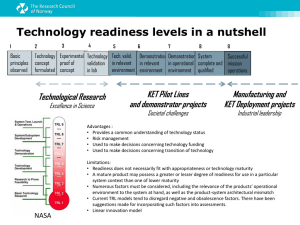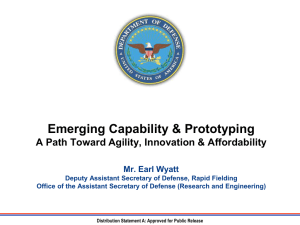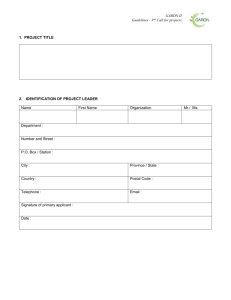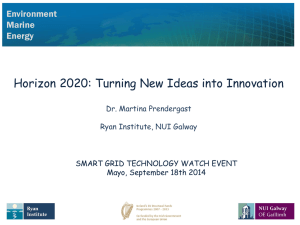An Approach to Technology Risk
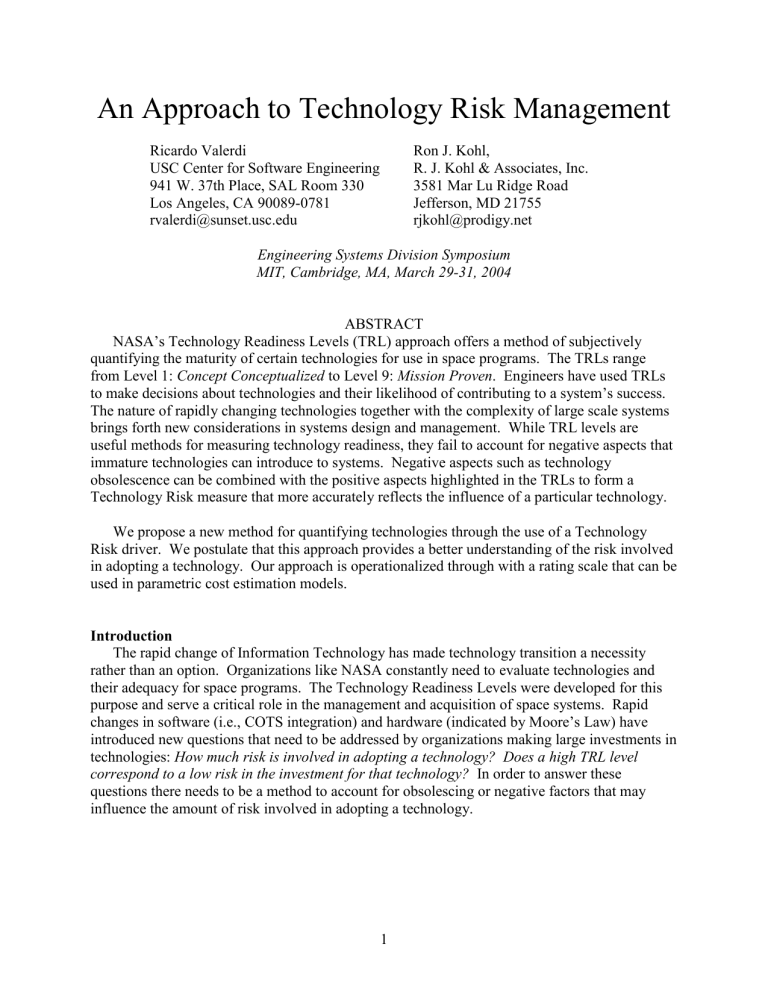
An Approach to Technology Risk Management
Ricardo Valerdi
USC Center for Software Engineering
941 W. 37th Place, SAL Room 330
Los Angeles, CA 90089-0781 rvalerdi@sunset.usc.edu
Ron J. Kohl,
R. J. Kohl & Associates, Inc.
3581 Mar Lu Ridge Road
Jefferson, MD 21755 rjkohl@prodigy.net
Engineering Systems Division Symposium
MIT, Cambridge, MA, March 29-31, 2004
ABSTRACT
NASA’s Technology Readiness Levels (TRL) approach offers a method of subjectively quantifying the maturity of certain technologies for use in space programs. The TRLs range from Level 1: Concept Conceptualized to Level 9: Mission Proven . Engineers have used TRLs to make decisions about technologies and their likelihood of contributing to a system’s success.
The nature of rapidly changing technologies together with the complexity of large scale systems brings forth new considerations in systems design and management. While TRL levels are useful methods for measuring technology readiness, they fail to account for negative aspects that immature technologies can introduce to systems. Negative aspects such as technology obsolescence can be combined with the positive aspects highlighted in the TRLs to form a
Technology Risk measure that more accurately reflects the influence of a particular technology.
We propose a new method for quantifying technologies through the use of a Technology
Risk driver. We postulate that this approach provides a better understanding of the risk involved in adopting a technology. Our approach is operationalized through with a rating scale that can be used in parametric cost estimation models.
Introduction
The rapid change of Information Technology has made technology transition a necessity rather than an option. Organizations like NASA constantly need to evaluate technologies and their adequacy for space programs. The Technology Readiness Levels were developed for this purpose and serve a critical role in the management and acquisition of space systems. Rapid changes in software (i.e., COTS integration) and hardware (indicated by Moore’s Law) have introduced new questions that need to be addressed by organizations making large investments in technologies: How much risk is involved in adopting a technology? Does a high TRL level correspond to a low risk in the investment for that technology?
In order to answer these questions there needs to be a method to account for obsolescing or negative factors that may influence the amount of risk involved in adopting a technology.
1
Current Technology Readiness Level Approaches
The Department of Defense and the General Accounting Office have been consistent proponents of the adoption of best business practices to improve the government acquisition process. Both organizations have identified technology readiness as key factors in successful product development.
In July 2001 memorandum, the Deputy Undersecretary of Defense for Science and
Technology officially endorsed the use of TRLs in new major programs (Graettinger et al 2002).
New DoD regulations require that the military services’ science and technology executives conduct a technology readiness level assessment for critical technologies identified in major weapon systems programs prior to the start of engineering and manufacturing development. The memorandum notes that technology readiness levels are the preferred approach for all new major programs unless the Deputy Undersecretary approves an equivalent assessment method.
The General Accounting Office sponsored a study to determine key factors in successful product development. They reported that one such key factor is maturing a new technology far enough to get it into the right size, weight, and configuration needed for the intended product.
After this is demonstrated, the technology is said to be at an acceptable level for product development (GAO 2001).
To improve the ability of programs to select mature technologies for inclusion in their programs, the GAO recommended the use of Technology Readiness Levels (TRL). TRLs were pioneered by the National Aeronautics and Space Administration in the early 90’s and adopted by the Air Force Research Laboratory, which promotes them as a means of evaluating the readiness of technologies to be incorporated into a weapon or other type of system (DOD 2002).
TRLs are being promoted as a gap assessment between a technology’s current maturity and the maturity needed for successful inclusion. The Air Force judges a technology to be low risk for the engineering and manufacturing development stage when:
a prototype of that technology has been developed that includes all of its critical components in approximately the same size and weight; and
that prototype has been demonstrated to work in an environment similar to that of the planned operational system
TRLs follow a scale from 1 ( Concept Conceptualized ) to 9 ( Mission Proven ). A technology assessed at TRL 1 is by definition at the lowest level of technology readiness, “where scientific research begins to be translated into applied research and development” (DOD 2002). By the time the technology has reached a TRL 9, the technology has progressed through formulation of an initial concept for application, proof of concept, demonstration in a laboratory environment and realistic environment, and integration into a system, and has been “flight qualified” and then
“flight proven.” This last state of development, where the technology is operating under mission conditions, is TRL 9. Table 1 provides a detailed description of the nine levels of the NASA technology maturation model.
2
Table 1.
NASA Technology Readiness Levels
Technology Readiness Level
1. Basic principles observed and reported.
2. Technology concept and/or application formulated.
Description
Lowest level of technology readiness. Scientific research begins to be translated into applied research and development. Examples might include paper studies of a technology’s basic properties.
Invention begins. Once basic principles are observed, practical applications can be invented. The application is speculative and there is no proof or detailed analysis to support the assumption. Examples are still limited to paper studies.
Active research and development is initiated. This includes analytical studies and laboratory studies to physically validate analytical predictions of separate elements of the technology. Examples include components that are not yet integrated or representative.
3. Analytical and experimental critical function and/or characteristic proof of concept.
4. Component and/or breadboard validation in laboratory environment.
5. Component and/or breadboard validation in a relevant environment.
Basic technological components are integrated to establish that the pieces will work together. This is relatively “low fidelity” compared to the eventual system. Examples include integration of “ad hoc” hardware in a laboratory.
6. System/subsystem model or prototype demonstration in an operation environment.
7. System prototype demonstration in an operational environment.
8. Actual system competed and
“flight qualified” through test and demonstration.
9. Actual system flight proven through successful mission operations.
Fidelity of breadboard technology increases significantly. The basic technological components are integrated with reasonable realistic supporting elements so that the technology can be tested in a simulated environment. Examples include “high fidelity” laboratory integration of components.
Representative model or prototype system, which is well beyond the breadboard tested for
TRL 5, is tested in a relevant environment. Represents a major step up in a technology’s demonstrated readiness. Examples include testing a prototype in a high fidelity laboratory environment or in simulated operational environment.
Prototype near or at planned operational system. Represents a major step up from TRL 6, requiring the demonstration of an actual system prototype in an operational environment, such as in an aircraft, vehicle, or space. Examples include testing the prototype in a test bed aircraft.
Technology has been proven to work in its final form and under expected conditions. In almost all cases this TRL represents the end of true system development. Examples include developmental test and evaluation of the system and in its intended weapon system to determine if it meets design specifications.
Actual application of the technology in its final form and under mission conditions, such as those encountered in operational test and evaluation. In almost all cases, this is the end of the last “bug fixing” aspects of true system development. Examples include using the system under operational mission conditions.
The DoD likes to invest in technologies that are at TRL 4 while government acquisition managers generally seek technologies at TRL 6 or higher. Most of the push by the DoD is to mature technologies that are at TRL 4 or below to at least a TRL 6, making the technologies more mature and ready for insertion into acquisition programs. The lower the maturity, or readiness, of an incoming technology, the more time and money will likely be needed to mature that technology to TRL 6. Thus, a TRL 4 or 5 is the minimum acceptable readiness level for an incoming technology that will satisfy program constraints.
TRLs are described in the DoD 5000.2-R document from a systems perspective, and thus are intended to be appropriate for both hardware and software. They are worded with the intent of being overarching definitions for any technology, while interpretations or amplifications for specific technologies are left to the experts in that technology domain.
Proposed approach
We propose that the current method for assigning technology readiness or maturity does not accurately capture the risk involved in adopting a technology. A holistic approach to technology risk includes obsolescing & negative factors which together with the TRLs provide a more accurate representation of technical risk. System developers have related TRL levels with risk in aircraft design (LeGresley et al 2000). The assumption used by many is that TRLs and
3
technology risk are inversely related, that is, the higher the TRL the lower the risk and vice versa as shown in Figure 1.
Figure 1.
Technology Readiness and Technology Risk (LeGresley et al 2000)
But organizations do not go beyond making the claim that there is a relationship between
TRLs and risk. Our premise is that the TRL model should account for factors that introduce new risks as technologies attain a high maturity level. These factors include the obsolescing of a given technology (e.g. vacuum tubes) and the leapfrogging of newer technologies over a given high maturity technology (e.g. integrated circuits vs. single transistors). Our contention is that a high maturity technology can actually take on new risks due to these types of ‘dampening’ factors and that this could cause an adoptee of that technology to reconsider their selection. We depict this effect in Figure 2.
Product Sustainment
9
TRL
Technology
Development
Product
Development
Product Aging
Obsolescence
1
Product Lifecycle
Figure 2.
Technology Readiness Level Throughout a Product Lifecycle
4
A particular technology could follow the progression depicted by the graph in Figure 2. The length of the lifecycle can depend on internal product specific factors or external market driven factors. Whichever the case, each technology will have its own unique curve. Once a technology has been developed and a product has been built from it, the user will enjoy a period of product sustainment whose length will be a function of the specific application domain.
Regardless of the length of the sustainment period, all technologies will eventually be replaced or become obsolete. This period of product aging and obsolescence is depicted by the dashed portion of the graph in Figure 2. We observe that the aging and obsolescent periods are triggered by ‘dampening’ factors and will have modest affects on a given technology’s risk level to the extent of reducing a given high TRL value only slightly. Two examples of ‘dampening’ factors are provided here.
First, obsolescence occurs in nearly all technologies and yet the TRL model does not provide for any acknowledgment of this ‘retiring’ factor for a given technology. The reasons for obsolescing are many but typically have to do with the ability of a given technology to remain supportable and cost effective for the functionality provided. In the case of the vacuum tube, as used in the telecommunications industry, the emergence of lower cost equivalent functionality was a primary driver that led to the obsolescing of the vacuum tube. In the case of integrated circuit boards, improved manufacturing techniques led to ever more densely packed circuit cards and eventually to integrated circuits.
Another major factor as to why a given ‘high TRL’ technology could loose some of its appeal is the emergence of a new but even better technology that provides nearly equivalent capabilities. This ‘leap frogging’ effect is not addressed in the TRL model. An example of this effect is the data storage technology. The transition from floppy disks to Compact Discs to even high capacity storage devices, at ever reducing costs for that storage, is well documented
(Christensen 1997). In this case, we notice that the computing industry adopted these changing data storage technologies, at first only as options because this ‘leap frogging’ technology was somewhat less mature than the current state of data storage technology but eventually was adopted as the primary data storage technology. All one has to do is consider the types of storage devices that are attached to or integrated into a modern laptop computer. It was less than
10 years ago that most laptop manufacturers were only offering a floppy drive as built in, but you could purchase an external CD reader. Today the most common built in storage devices are CD burners with new external storage devices.
We note that both of these ‘dampening’ factors could lead to reconsideration of adopting a given technology, even one that is of the highest ‘maturity’ or the alternative consideration of other technologies (including ones of lower ‘maturity’) due to these factors.
Application in Cost Models
Parametric cost models are useful tools for developing “what if” scenarios or trade studies.
The Constructive Systems Engineering Cost Model (COSYSMO) was developed to estimate the amount of systems engineering effort required for large-scale systems. It includes eighteen drivers that capture the scope of a chosen system-of-interest and are divided into four categories: product, platform, personnel, and project (Valerdi et al 2003). One of the most significant of
5
these factors is Technology Risk . The COSYSMO Working Group, made up of over a dozen systems engineers with cost estimating experience, developed the driver definitions and rating scales. The rating scales represent the different levels of influence a particular driver can have on overall systems engineering effort. The rating scale for the Technology Risk driver is shown in Table 2. Given that not all organizations use the NASA TRL ratings we have created an equivalent scale that captures the readiness of certain maturities. TRL levels 1 and 2 are not of major concern in Systems Engineering since they rarely appear in fielded systems; therefore they are not included in COSYSMO.
Table 2. Rating Scale for Technology Risk Driver in COSYSMO
Viewpoint Very Low
Lack of Maturity Technology
Lack of
Readiness proven and widely used throughout industry
Mission proven
(TRL 9)
Obsolescence
Cost multiplier
(Obsolescence not an issue)
0.68
Low
Proven through actual use and ready for widespread adoption
Concept qualified (TRL
8)
(Obsolescence not an issue)
0.82
Nominal
Proven on pilot projects and ready to roll-out for production jobs
Concept has been demonstrated
(TRL 7)
Technology is the state-of-thepractice; emerging technology could compete in future
1.0
High
Ready for pilot use
Proof of concept validated (TRL 5
& 6)
Technology is stale; new and better technology is on the horizon in the near-term
1.32
Very High
Still in the laboratory
Concept defined
(TRL 3 & 4)
Technology is outdated and use should be avoided in new systems; spare parts supply is scarce
1.75
The three different viewpoints provided offer the necessary perspectives for evaluating the risk involved in adopting a technology. Lack of maturity and readiness are synonyms while obsolescence represents an opposing feature. Because of the polarity of the driver we are currently using a double negative for the viewpoints. That is, technology risk is a negative term because the more of it you have, the worse it is. Following this tone we have used the terms
“lack or maturity” and “lack of readiness” to keep the same polarity throughout the driver viewpoints. Having low “lack of” readiness or maturity is the same as having high readiness or maturity. This results in a “low” technology risk.
The rating levels range from a “Very Low” to a “Very High” level of Technology Risk , each with their separate influence on systems engineering effort. The “Nominal” case (concept has been demonstrated, TRL 7, and technology is state-of-the-practice) is considered to have neither a positive nor negative effect on systems engineering effort. As such it is assigned a cost multiplying factor of 1.0. A “Low” level of Technology Risk has a rating of 0.82 which indicates there is a 18% savings in the systems engineering effort compared to the “Nominal” case.
Similarly the 0.68 rating for “Very low” level of Technology Risk results in a 32% savings in systems engineering effort compared to the “Nominal” case. On the other hand, the “High” and
“Very High” levels of
Technology Risk have a corresponding 32% and 75% effort penalty compared to the “Nominal” case. The five cost multiplying factors are shown in Figure 3. It is
6
important to note the difference in slope between the “Very Low” to “Nominal” levels and the
“Very High” to “Nominal”. The latter has a steeper slope thus denoting the increased risk of using immature technologies.
1.8
Very High
1.6
1.4
1.2
High
1
Nominal
0.8
Low
Very Low
0.6
Driver Rating Level
Figure 3.
Technology Risk Driver Cost Multipliers
The cost multiplier values in Figure 3 were collected by surveying 40 Systems Engineering experts familiar with cost estimation through the use of a Wideband Delphi technique. This technique has been proven to show reliable results in other estimation efforts (Dalkey 1967).
The subjects that responded to the COSYSMO Delphi survey were mostly comprised of members of the International Council on Systems Engineering (INCOSE) which were familiar with systems engineering measurement. The COSYSMO Working Group also held multiple meetings to validate and define the set of drivers and their corresponding cost multipliers.
Conclusion
The current NASA Technology Readiness Level model, while useful, is incomplete due to its disregard for negative or obsolescence factors. The proposed refined approach includes these factors and offers a Technology Risk perspective. This perspective provides a more accurate representation of the negative factors that can surface as a result of highly mature technologies.
The risk associated with immature or obsolescent technologies may provide warning signs for systems that require major capital investments. Technology maturity is an important part of large-scale systems and its risks are not simply those that relate to technology. There are broader business issues that demand more complete consideration. These issues are beyond the scope of this paper but are equally important.
The Technology Risk driver represents an effort to quantify a very subjective phenomenon.
While there are some inaccuracies in this approach it captures the idea that immature or obsolescent technologies require more systems engineering effort because of the risk involved, as shown by the COSYSMO Technology Risk driver.
7
It is not yet clear to the authors that the effects of the obsolescing will be quantitatively the same as that of the ‘leapfrogging’ effect and this will require more research to determine.
Furthermore, it is possible that there may be additional ‘dampening’ factors that could also introduce some level of risk in a high maturity technology and we continue to search for such additional factors.
References
Christensen, C.,
The Innovator’s Dilemma: When New Technologies Cause Great Firms to Fail
,
Harvard Business School Press, 1997.
Dalkey, N. C., Delphi , The RAND Corporation, P-3704, October 1967.
DoD 5000.2-R, “Mandatory Procedures for Major Defense Acquisition Programs (MDAPS) and
Major Automated Information Systems (MAIS) Acquisition Programs,” 5 April 2002.
GAO, “Joint Strike Fighter Acquisition—Mature Critical Technologies Needed to Reduce
Risks.” GAO-02-39, October 2001.
Graettinger, C. P., Garcia, S., Siviy, J., Schenk, R. J., Van Syckle, P. J., “Using the Technology
Readiness Levels Scale to Support Technology Management in the DoD’s ATD/STO
Environments,” Army CECOM, September 2002.
LeGresley, P., Bathke, T., Carrion, A., Cornejo, J.D., Owens, J., Vartanian, R., Alonso, J. J.,
Kroo, I. M., AIAA Foundation Graduate Team Aircraft Design Competition: Super STOL
Carrier On-board Delivery Aircraft , Society of Automotive Engineers Department of
Aeronautics and Astronautics, Stanford University, 2000.
Valerdi, R., Boehm, B., Reifer, D., “COSYSMO: A Constructive Systems Engineering Cost
Model Coming Age,” Proceedings of the 13th Annual International INCOSE Symposium ,
July 2003, Crystal City, VA.
8
